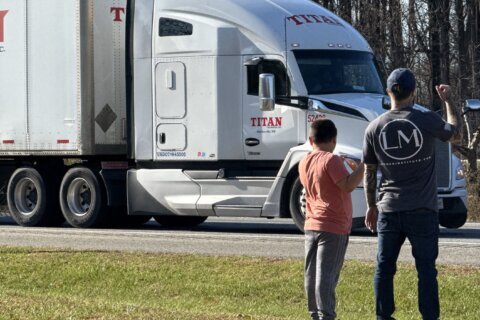Nearly 1.3 million D.C.-area residents are expected to travel this Thanksgiving holiday, according to AAA projections released Tuesday.
That’s up 13% from 2020, but still 9% lower than 2019.
The vast majority of travelers will hit the road. AAA projects 93% of travelers will be driving — nearly 1.2 million. That’s the fourth-highest number since AAA has been keeping record, and up almost 10% over last year.
AAA said part of the bounce back from 2020 has to do with how people feel about traveling now. According to a poll of residents, only 14% said traveling over the Thanksgiving holiday poses a “significant” risk for COVID-19.
“Both the Thanksgiving travel projections and the results of AAA’s poll of District drivers tell the same story. Many Thanksgiving travelers see COVID in the rear-view mirror and they are looking forward to returning to the pre-pandemic tradition of gathering with family and friends,” Ragina C. Ali, public and government affairs manager at AAA Mid-Atlantic, said in a news release.
“Travelers should expect — and plan for — both the roadways and airports to be as busy as ever.”
Air travel is also taking off this year over 2020. AAA projects more than 76,000 residents will fly, which is an 80% jump. But it’s still down 25% from the residents who flew over the Thanksgiving holiday in 2019.
As for bus and train ridership, that’s up too. AAA said it expects almost 10,000 residents to travel by bus, train or some other mode. That’s a 260% jump over 2020, but 60% lower than 2019.
Here are the numbers:
|
Thanksgiving Holiday Travel Across Washington, D.C. |
||||
|
|
Total |
Automobile |
Air |
Other (Bus, Train, Cruise) |
|
2021 (Forecast) |
1,265,000 |
1,180,000 |
76,000 |
9,700 |
|
2020 (Actual) |
1,120,000 |
1,075,000 |
42,200 |
2,700 |
|
2019 (Actual) |
1,388,000 |
1,261,000 |
101,270 |
25,770 |
|
Change (2019 to 2021) |
−8.9% |
−6.5 % |
−25% |
-62% |
|
Change (2020 to 2021) |
+13% |
+9.7% |
+80.5 % |
+262% |
With so many people getting behind the wheel, you obviously want to keep gas in the tank.
And gas prices are definitely up.
Nationally, AAA said the average gas price as of Monday was $3.41, an increase of $1.29 over last year. That’s also the highest gas prices have been at this time of year since 2013.
In D.C., the average was $3.62, up 90 cents more than this time in 2020.
But that doesn’t mean people are going to stay put.
“Historically, higher gas prices have not kept travelers home,” Ali said in the release. “Instead, they adjust their budgets to spend less on other expenses such as meals or lodging.”
With a projected 1.2 million expected to drive, the roads will be bustling, and that means timing will be key.
INRIX, in conjunction with AAA, expects the worst congestion to happen as commuters leave work early and mix with holiday travelers.
“Major metro areas across the U.S. could see more than double the delays versus typical drive times,” the release said.
Below are the best and worst times to travel, according to INRIX.
|
Daily Worst and Best Times to Travel |
||
| Day | Worst Time | Best Time |
| Wednesday | 12 p.m. – 8 p.m. | After 9 p.m. |
| Thursday | 12 p.m. – 3 p.m. | Before 11 a.m. |
| Friday | 1 p.m. – 4 p.m. | Before 11 a.m. |
| Saturday | 2 p.m. – 7 p.m. | Before 12 p.m. |
| Sunday | 1 p.m. – 7 p.m. | Before 12 p.m. |
|
Source: INRIX |
||








